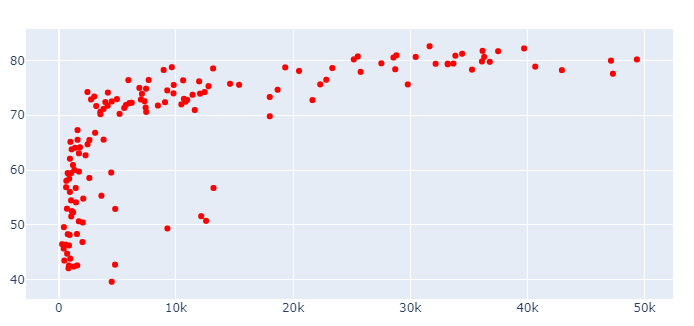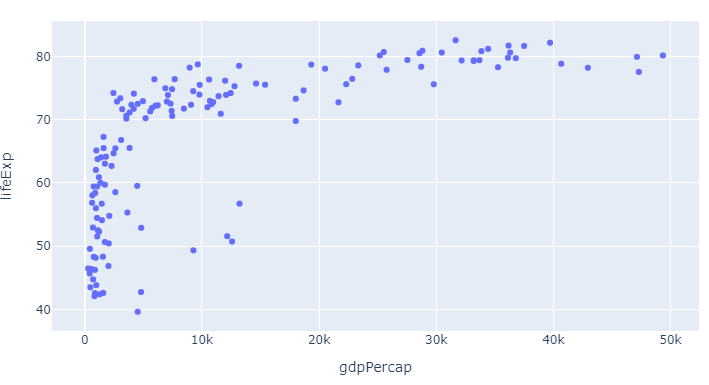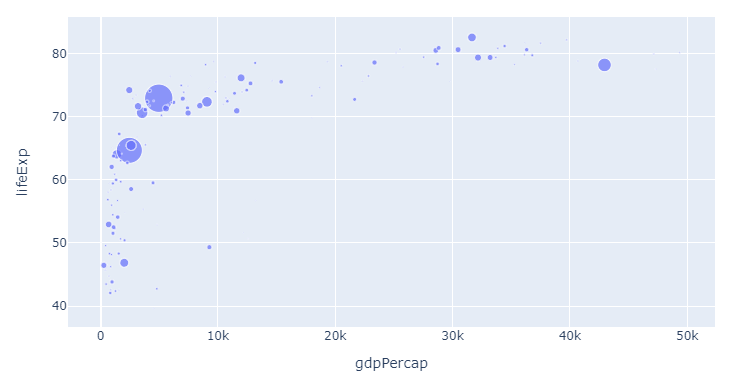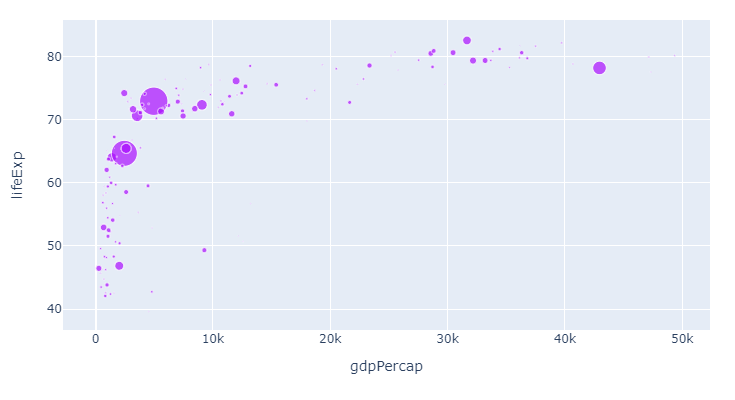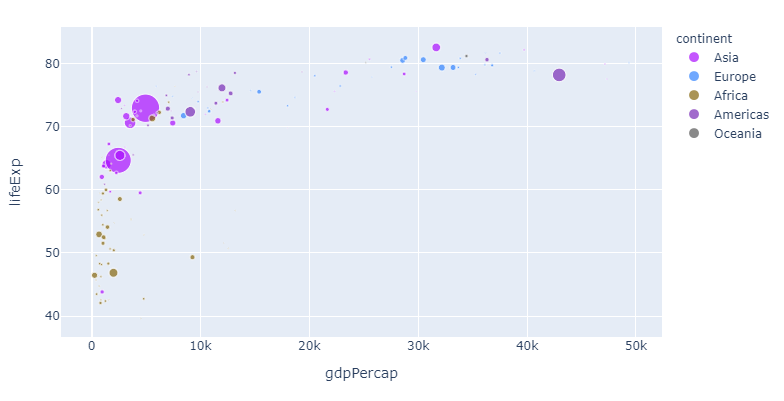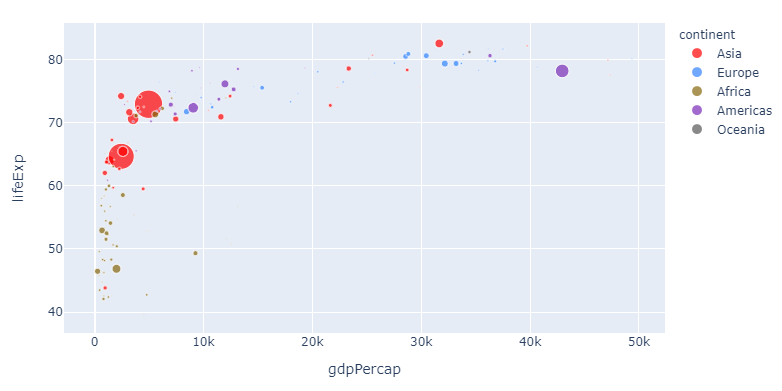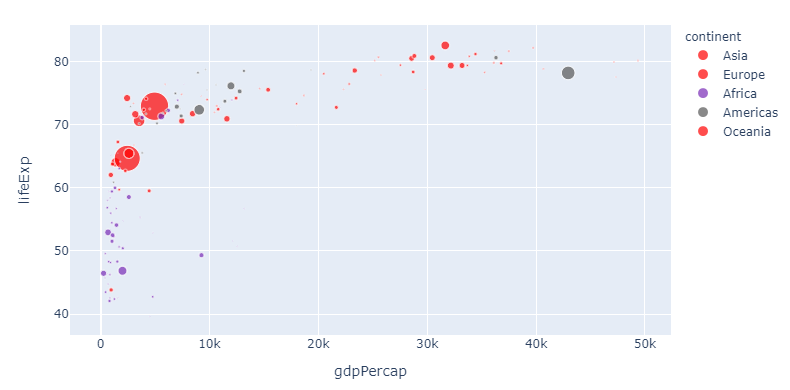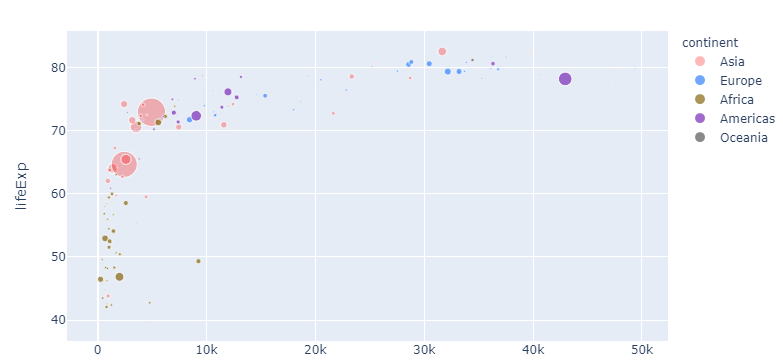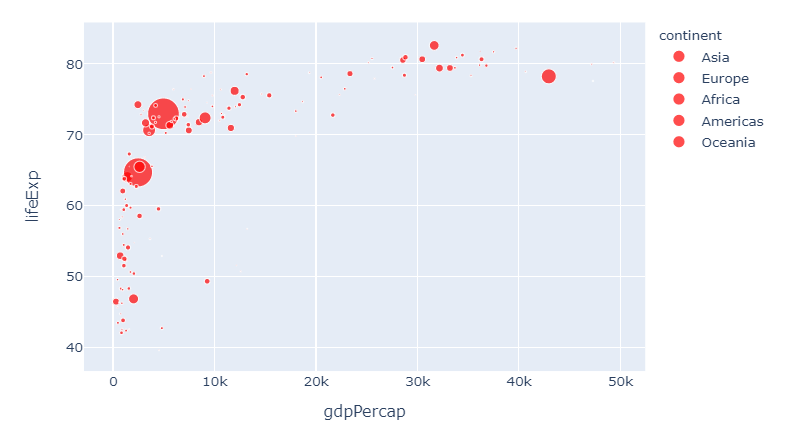First, if an explanation of the broader differences between go and px is required, please take a look here and here. And if absolutely no explanations are needed, you'll find a complete code snippet at the very end of the answer which will reveal many of the powers with colors in plotly.express
Part 1: The Essence:
It might not seem so at first, but there are very good reasons why color='red' does not work as you might expect using px. But first of all, if all you'd like to do is manually set a particular color for all markers you can do so using .update_traces(marker=dict(color='red')) thanks to pythons chaining method. But first, lets look at the deafult settings:
1.1 Plotly express defaults
Figure 1, px default scatterplot using px.Scatter
![enter image description here]()
Code 1, px default scatterplot using px.Scatter
# imports
import plotly.express as px
import pandas as pd
# dataframe
df = px.data.gapminder()
df=df.query("year==2007")
# plotly express scatter plot
px.scatter(df, x="gdpPercap", y="lifeExp")
Here, as already mentioned in the question, the color is set as the first color in the default plotly sequence available through px.colors.qualitative.Plotly:
['#636EFA', # the plotly blue you can see above
'#EF553B',
'#00CC96',
'#AB63FA',
'#FFA15A',
'#19D3F3',
'#FF6692',
'#B6E880',
'#FF97FF',
'#FECB52']
And that looks pretty good. But what if you want to change things and even add more information at the same time?
1.2: How to override the defaults and do exactly what you want with px colors:
As we alread touched upon with px.scatter, the color attribute does not take a color like red as an argument. Rather, you can for example use color='continent' to easily distinguish between different variables in a dataset. But there's so much more to colors in px:
The combination of the six following methods will let you do exactly what you'd like with colors using plotly express. Bear in mind that you do not even have to choose. You can use one, some, or all of the methods below at the same time. And one particular useful approach will reveal itself as a combinatino of 1 and 3. But we'll get to that in a bit. This is what you need to know:
1. Change the color sequence used by px with:
color_discrete_sequence=px.colors.qualitative.Alphabet
2. Assign different colors to different variables with the color argument
color = 'continent'
3. customize one or more variable colors with
color_discrete_map={"Asia": 'red'}
4. Easily group a larger subset of your variables using dict comprehension and color_discrete_map
subset = {"Asia", "Africa", "Oceania"}
group_color = {i: 'red' for i in subset}
5. Set opacity using rgba() color codes.
color_discrete_map={"Asia": 'rgba(255,0,0,0.4)'}
6. Override all settings with:
.update_traces(marker=dict(color='red'))
Part 2: The details and the plots
The following snippet will produce the plot below that shows life expectany for all continents for varying levels of GDP. The size of the markers representes different levels of populations to make things more interesting right from the get go.
Plot 2:
![enter image description here]()
Code 2:
import plotly.express as px
import pandas as pd
# dataframe, input
df = px.data.gapminder()
df=df.query("year==2007")
px.scatter(df, x="gdpPercap", y="lifeExp",
color = 'continent',
size='pop',
)
To illustrate the flexibility of the methods above, lets first just change the color sequence. Since we for starters are only showing one category and one color, you'll have to wait for the subsequent steps to see the real effects. But here's the same plot now with color_discrete_sequence=px.colors.qualitative.Alphabet as per step 1:
1. Change the color sequence used by px with
color_discrete_sequence=px.colors.qualitative.Alphabet
![enter image description here]()
Now, let's apply the colors from the Alphabet color sequence to the different continents:
2. Assign different colors to different variables with the color argument
color = 'continent'
![enter image description here]()
If you, like me, think that this particular color sequence is easy on the eye but perhaps a bit indistinguishable, you can assign a color of your choosing to one or more continents like this:
3. customize one or more variable colors with
color_discrete_map={"Asia": 'red'}
![enter image description here]()
And this is pretty awesome: Now you can change the sequence and choose any color you'd like for particularly interesting variables. But the method above can get a bit tedious if you'd like to assign a particular color to a larger subset. So here's how you can do that too with a dict comprehension:
4. Assign colors to a group using a dict comprehension and color_discrete_map
# imports
import plotly.express as px
import pandas as pd
# dataframe
df = px.data.gapminder()
df=df.query("year==2007")
subset = {"Asia", "Europe", "Oceania"}
group_color = {i: 'red' for i in subset}
# plotly express scatter plot
px.scatter(df, x="gdpPercap", y="lifeExp",
size='pop',
color='continent',
color_discrete_sequence=px.colors.qualitative.Alphabet,
color_discrete_map=group_color
)
![enter image description here]()
5. Set opacity using rgba() color codes.
Now let's take one step back. If you think red suits Asia just fine, but is perhaps a bit too strong, you can adjust the opacity using a rgba color like 'rgba(255,0,0,0.4)' to get this:
![enter image description here]()
Complete code for the last plot:
import plotly.express as px
import pandas as pd
# dataframe, input
df = px.data.gapminder()
df=df.query("year==2007")
px.scatter(df, x="gdpPercap", y="lifeExp",
color_discrete_sequence=px.colors.qualitative.Alphabet,
color = 'continent',
size='pop',
color_discrete_map={"Asia": 'rgba(255,0,0,0.4)'}
)
And if you think we're getting a bit too complicated by now, you can override all settings like this again:
6. Override all settings with:
.update_traces(marker=dict(color='red'))
![enter image description here]()
And this brings us right back to where we started. I hope you'll find this useful!
Complete code snippet with all options available:
# imports
import plotly.express as px
import pandas as pd
# dataframe
df = px.data.gapminder()
df=df.query("year==2007")
subset = {"Asia", "Europe", "Oceania"}
group_color = {i: 'red' for i in subset}
# plotly express scatter plot
px.scatter(df, x="gdpPercap", y="lifeExp",
size='pop',
color='continent',
color_discrete_sequence=px.colors.qualitative.Alphabet,
#color_discrete_map=group_color
color_discrete_map={"Asia": 'rgba(255,0,0,0.4)'}
)#.update_traces(marker=dict(color='red'))

